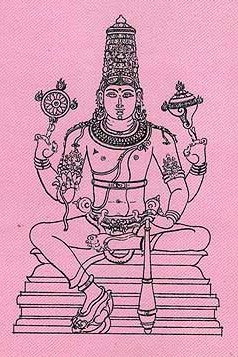Dhamatraya, Dhāmatraya, Dhama-traya: 2 definitions
Introduction:
Dhamatraya means something in Hinduism, Sanskrit. If you want to know the exact meaning, history, etymology or English translation of this term then check out the descriptions on this page. Add your comment or reference to a book if you want to contribute to this summary article.
In Hinduism
Pancaratra (worship of Nārāyaṇa)
Source: archive.org: Isvara Samhita Vol 5Dhāmatraya (धामत्रय) or Dhāmatrayamudrā is the name of a mudrā described in the Īśvarasaṃhitā 54-55.—Accordingly, “after joining the index finger and the thumb of the right hand,that formation shall be disconnected slowly. The group of fingers should be made supine separately (one by one). This is the mudrā of the three dhāmans, that of Gaṇeśa is stated there”. Mūdra (eg., Dhāmatraya-mudrā) is so called as it gives joy to the tattvas in the form of karman for those who offer spotless worship, drive out the defects which move about within and without and sealing up of what is done.
Note: The sun, moon and fire constitute the three dhāmas; lustres or light. Mudrās of Gaṇeśa and others are stated here to be treated but Gaṇeśa’s name does not occur with the mudrā.

Pancaratra (पाञ्चरात्र, pāñcarātra) represents a tradition of Hinduism where Narayana is revered and worshipped. Closeley related to Vaishnavism, the Pancaratra literature includes various Agamas and tantras incorporating many Vaishnava philosophies.
Shaktism (Shakta philosophy)
Source: Google Books: ManthanabhairavatantramDhāmatraya (धामत्रय) [=Tridhāma?] refers to the “three abodes” (of the universe), according to the commentary on the Ṣaṭsāhasrasaṃhitā, an expansion of the Kubjikāmatatantra: the earliest popular and most authoritative Tantra of the Kubjikā cult.—Accordingly, “Kubjikā is the crooked (energy) of those two (the Sun and the Moon). [...] Or else, (one can say that) she is crooked in all circumstances and (as such) is the Peak seed-syllable AIṂ. Or else (one can say that) she is in a state of oneness [i.e., aikyabhūtā] or, she pervades everywhere in (her) contracted state. She who possesses (all these states and forms of being) is Kubjikā. The universe, consisting of the three abodes [i.e., dhāmatraya], is merged and develops within her residence. This is the description of Kubjikā”.

Shakta (शाक्त, śākta) or Shaktism (śāktism) represents a tradition of Hinduism where the Goddess (Devi) is revered and worshipped. Shakta literature includes a range of scriptures, including various Agamas and Tantras, although its roots may be traced back to the Vedas.
See also (Relevant definitions)
Partial matches: Traya, Dhama, Tama.
Starts with: Dhamatrayamudra.
Full-text: Tridhaman, Dhamatrayamudra.
Relevant text
No search results for Dhamatraya, Dhama-traya, Dhāma-traya, Dhāmatraya; (plurals include: Dhamatrayas, trayas, Dhāmatrayas) in any book or story.